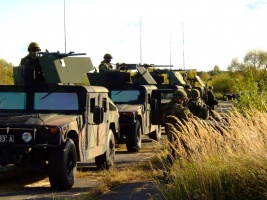SILVER SPRING, Md., June 17, 2010 — Wind tunnels, the tools used to simulate airspeed environments to test flight capabilities, have come a long way since the Wright brothers built a box with fans to test a kite model.
At the Air Force’s Arnold Engineering Development Center White Oak site here, the breadth of that change is apparent. The original supersonic tunnel, created by Werner von Braun and other German scientists to test weapon aerodynamics in World War II, sits in a lobby a few yards away from its most-recent descendent, Hypervelocity Wind Tunnel 9, which can produce wind conditions simulating hypersonic speeds, up to Mach 14.
Site director Dan Marren said Tunnel 9 is unique in the truest sense of the word: there are no wind tunnels like it anywhere else. The tunnel uses a 200,000-cubic-foot, seven-story sphere as a vacuum on one end, and nitrogen compressed to 30,000 pounds per square inch and heated to 3,000 degrees Fahrenheit to create a pressure ratio of about 1 million, which is needed to create hypersonic wind conditions.
“Anything that goes fast will probably come to us [for testing],” he said.
The tunnel is revolutionary because of the amount of high quality data it produces, Marren said. It can run two tests daily, and record large amounts of data while moving the model dynamically. Prior to its creation, he noted, it might take two months to gather the data from a day’s work with Tunnel Nine. It’s especially important, he added, because neither the research nor the scientists involved can be replicated.
“If you moved this [wind tunnel] anywhere in the world, you couldn’t use it unless you brought these people with it,” he said. “My staff is unique.”
A commercial airliner generally flies between 500 and 600 miles per hour – well below the supersonic threshold. A bullet fired from a gun flies at Mach 2, twice the speed of sound. The SR-71 Blackbird, the fastest manned aircraft, travels just over Mach 3.
In Tunnel 9, air travels nearly 4,800 feet per second, well beyond human experience, Marren said. A human could not survive flight at that speed, he added, because the friction would melt skin and tear a body apart.
“At these speeds, one wrong factor can mean disaster,” Marren said. “So we have to prescribe exact specifications based on our gathered data to make sure our people and equipment survive at high speeds.”
Marren said the testing here has been critical to the development of missile defense systems that are currently being tested over the Pacific Ocean, and in the development of a “prompt global strike” system that would allow rapid response to emerging threats globally, either through satellite reconnaissance or weapons delivery.
“The stuff we do is aimed to shorten a campaign, or eliminate the need for it,” Marren said. “If what we do can eliminate the need to have a forward operating base or to send people into harm’s way, we’re all about it.”
Among the devices that have been tested in Tunnel 9 are the X‑37B Orbital Test Vehicle, an unmanned space vehicle, and the Hypersonic Technology Vehicle, a waverider-based unmanned hypersonic vehicle that flies nearly 500,000 feet above sea level at the upper edge of the atmosphere.
Marren’s crew tests the vehicles to ensure their equipment and payloads won’t be destroyed by the heat or pressure of air at hypersonic speed.
“Once you do all of that, you have to come home,” Marren said. “We cover the ‘come home’ part.”
Mark Lewis, the former chief scientist for the Air Force and a professor of aerospace engineering at the University of Maryland, said the beauty of the testing done at White Oak is in the application. He said hypersonic flight gives the Air Force the capability to respond faster than ever before.
“Hypersonics allow us to get more information on a bad situation before it becomes a full-blown bad situation,” Lewis said. “If we need something to be somewhere, I can get there faster than anyone.”
Lewis added that the research program at White Oak is an excellent opportunity for students pursuing degrees or a career in aerospace engineering, and provides an excellent environment to bring theories from academic research to testing and evaluation.
He said new ideas about how to use wind tunnels to test concepts and theories have come from having academic access to Tunnel Nine, and the experiments performed there have vastly increased the scientific community’s knowledge of high-speed flight and space access.
“What better way is there to get students interested in this career?” Lewis said. “It’s the most amazing motivator for students; to see the work they’re doing applied in real life and used by the military.”
Source:
U.S. Department of Defense
Office of the Assistant Secretary of Defense (Public Affairs)

 von
von 